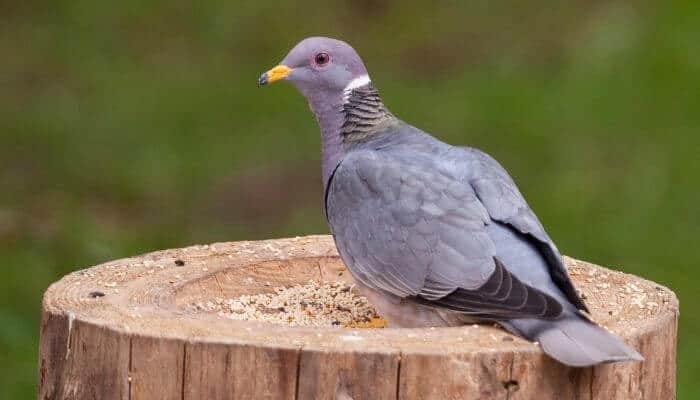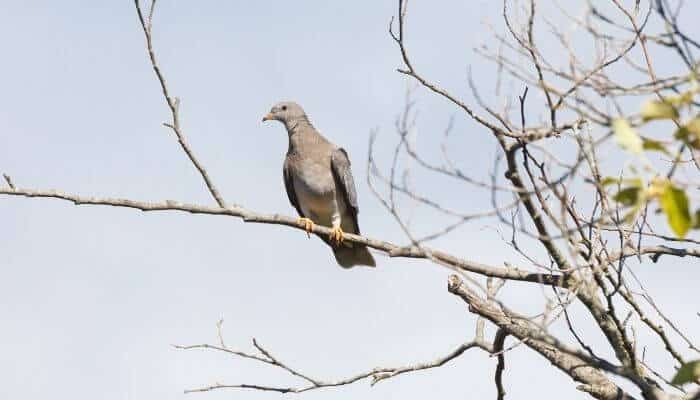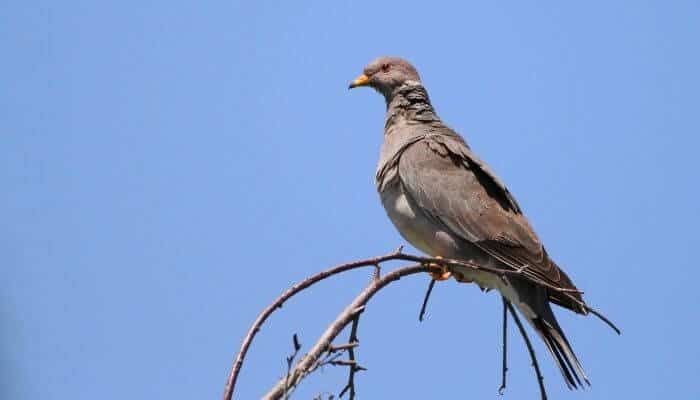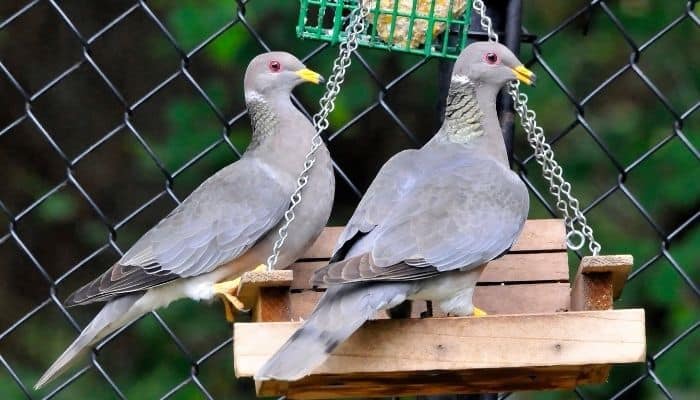Sometimes referred to as the blue rock pigeon, the band-tailed pigeon is a descendant of the extinct passenger pigeon.
It was once a popular game pigeon, then fell out of favor among hunters due to the decreased numbers.
This allowed the numbers to flourish again because the hunters went to other birds for their sport.
The band-tailed pigeon is native to and is the biggest type of pigeon in North America.
It’s a common sight in the mountains of many states.
Band-Tailed Pigeon Origin & Habitat
Native to North America, specifically the western portion, band-tailed pigeons have two subspecies, the Pacific Coast subspecies and the Interior or Four Corners species.
- The Pacific coast pigeons can be found in Oregon, California, Nevada, Alaska, Washington and British Columbia. These birds like the wet rainforests between sea level and 1,000 feet.
- The Four Corners pigeons make their home in Colorado, Arizona, New Mexico and Utah. They are typically found in elevations between 5,000 and 10,000 feet.
Both subspecies migrate in the fall, working their way south into Baja, Mexico and Central America.

They can usually be found in mountain forests of coniferous trees and those that produce fruit for food.
The Decline and Rise Of The Blue Tail Pigeon
History reports that millions of band-tails used to inhabit the mountains of North America.
Now, according to Partners in Flight, there are approximately 2 million.
Unprotected by any laws, the birds were shot in great numbers prior to 1912.
The band-tails were seen as pests to agriculture and were also farmed for their meat which is said to be tastier than other types of pigeon meat.
There was public outrage when it was released how many were being slaughtered with concern that the band-tail might go the way of the passenger pigeon and become extinct.
The band tail was placed under federal protection.

Although hunting had resumed again by the mid-20th century, Washington regulators decreed closed hunting seasons for the years 1991-2001 enabling recovery from the over-hunting.
These days, hunting happens in California, Oregon, Washington, Arizona, Colorado, New Mexico and Utah with around 2,500 birds shot every year.
The pigeons also face a challenge as their habitats are reduced through deforestation although in North America this is hardly anywhere near as extensive as in other countries.
As a game bird, it is a worthy adversary for any hunter.
They are elusive and challenging to find and are considered a wingshooter’s dream.
Band-tailed pigeons are alert, and a flock will have lookouts posted in the tops of trees.
They have excellent eyesight and are fast fliers.
Band-Tail Characteristics
Band-tails are stocky with small heads, pointed wings and long, rounded tails.
As the largest breed in North America, the band-tailed pigeon reaches a size of 13 to 16 inches long and a weight of between 8 and 18 ounces, on average.
The band-tailed pigeon’s call is two syllables and is often compared to an owl’s, both in sound and volume.
Sometimes it will make a loud, squawking sound, though there isn’t a known reason for this.
It also features a tail band and iridescent feathers on its neck and plumage.
Also Read: Eurasian Collared Dove: Breed Guide
Coloring
Juvenile band-tailed pigeons are grey in colour.
Like some other species of pigeons, adult males and females look alike.
They are mostly grey, with a lighter tail, featuring a darker distinctive band that gives them their name.

They have a red eye ring and a white collar around their neck, with a crescent-shaped patch of shiny green/bronze feathers beneath it.
Adults also boast a mauve colour on their chests and bellies.
Wings are plainly coloured but have black wingtips that can be seen while they are in flight.
Unusually, the band tail has yellow legs and feet and also a black-tipped yellow beak.
Diet
Like many other birds, band-tailed pigeons subsist on a diet of plant matter.
That includes things like nuts, seeds and berries.
Toyon berries are one of this bird’s favourites, but they also like blackberries, cherries and elderberries.
They will also eat buds and flowers.
Twice a year, band-tailed pigeons gather at mineral springs to eat the salts.
As summer ends, they tend to eat a lot more fruit, likely in preparation for colder weather and for the energy to migrate south when the time comes.
Behaviour
Similar to a variety of other birds, band-tailed pigeons are foragers, often looking for food in groups, due to their naturally social nature.
Typically you can see them foraging in trees, often flying over each from tree to tree to stay in front of the pack.
They are also known to forage on the ground.
Individuals have been known to travel in excess of 30 miles daily for food and water.
Groups of band-tailed pigeons are nomadic, and they often follow the acorn crop.
Breeding Band-Tailed Pigeons
Band-tailed pigeons aren’t highly desired for breeding as they are not ornamental or show pigeons, but they are more well known as game birds.
Though they were once over-hunted, their populations have increased, and they are commonly seen in their natural habitats.

Numbers tend to fluctuate as the birds’ popularity as game waxes and wanes.
They may not be the most popular breeding pigeon, but they do have a specific breeding process in the wild.
Several pairs of band-tailed pigeons nest together, high in trees, at about 15 to 40 feet off the ground.
The male collects the nest material, and the female puts it together.
Each clutch contains one or two eggs and the male and female take turns incubating.
Incubation takes between 18 and 20 days and the babies remain in the nest for four weeks after hatching.
Both the mother and the father participate in caring for the babies, feeding them crop milk, which is high in protein and fat and helps the babies grow.
It has been observed that some band-tailed pigeon couples complete the nesting process three times a year.
Whether you’re looking for a game bird or are simply interested in everything that pigeons have to offer, there’s something special about the band-tailed pigeon.
Resources:
